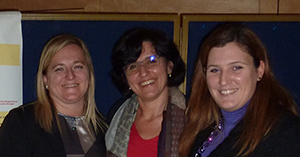Blogs
Focus on Slovenia: Martina Ozbič, Damjana Kogovšek, Jerneja Novšak Brce

The Linguistic Context
The Slovenian language is a fusional / inflected language, morphologically very rich. It allows a free word order; subject omission; transitive and intransitive valency among verbs (avalent, intransitive, transitive, ditransitive); perfective and imperfective aspects, 3 verb moods (indicative, imperative, and conditional mood); active and passive voice; 3 genders; 3 persons and 3(4) tenses. In the phonotactic domain, the Slovenian language is challenging; it contains several consonant clusters in all word positions (typical syllable structures are CV, CCV, CVC, CVCC in CCVC etc.). The stress pattern is also rich, although some patterns occur more frequently, i.e. Sw, wSw, Sww.
As a result of these morphological features, the Slovenian language is very challenging for a developing child, and especially so for those with Language Impairment (LI).
Our Research
As in many other Slavic languages, there is a lack of instruments for language assessment, and the Speech and Language researchers at the University of Ljubljana are trying our best to fill the gap. In order to offer instruments to clinicians, we have focused our work on profiles, tests and language measures.
Alongside those at a professorial and postdoctoral level, Speech and language therapy students are also actively involved in research, i.e. Tamara Sevšek, Ana Praprotnik, Tjaša Kerin, Patricija Plaznik, and Moira Berginc are some promising names to look out for in the coming years.
We are currently working on the following projects:
- We are adapting LARSP (Language Assessment, Remediation and Screening Procedure) (Crystal et al., 1976) and testing the chart on typical language development and language impairment in collaboration with the linguist Darija Skubic. The chart is very useful to determine the language level of the child.
- Concerning narration, we are analyzing narratives of typically developing (TD) and language impaired (LI) children, aged 6-10 years.
- We are also adapting the test for language impairment from Italian to Slovenian (BVL 4-12: Marini, Bulgheroni, Marotta, Fabbro. 2015). This is a test with a wide scope, from phonetics to pragmatics.
The COST Action
Taking part in COST Action IS1406 is a great opportunity to share knowledge, experience and instruments with colleagues from across Europe and beyond. The Action is also a great forum through which to bring the Slovenian language and SLT community into wider discussions. It is hoped that the work on the COST Action survey in particular will help put Slovenian Speech and Language Therapy issues on the map.
The Slovenian Team: Martina Ozbič, Damjana Kogovšek, Jerneja Novšak Brce
Last modified: Fri, 17 Feb 2017 12:05:21 GMT



